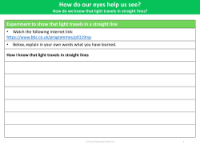How do we know that light travels in a straight line? - Teacher's Notes

Science Resource Description
The concept that light travels in straight lines is an important foundation of optics and is demonstrated through a series of experiments that pupils can observe and conduct. The teacher's notes suggest starting with a video from a reputable source to introduce the idea. Following this, two practical experiments are recommended to reinforce the concept. In the first experiment, a presenter uses three pieces of card with holes punched in them. When the cards are aligned unevenly, the light is unable to pass through all three holes, illustrating that light does not bend around corners. However, when the holes are aligned in a straight line, the light passes through seamlessly, confirming that light travels in a straight path.
The second experiment further explores the behaviour of light using a light source and a shiny, uneven surface. This setup shows that although light travels straight, it can scatter and reflect in various directions when it hits an irregular surface. Pupils are then encouraged to conduct their own experiments to observe light's linear reflection. They use provided materials to set up the experiment and are asked to write up their findings, engaging in metacognitive work by reflecting on their experimental process. These activities not only demonstrate the straight-line propagation of light but also help pupils understand how our eyes rely on this property to see the world around us.






